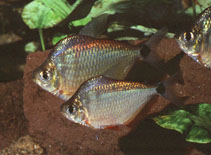| Family: |
Characidae (Characins; tetras), subfamily: Tetragonopterinae |
| Max. size: |
11.2 cm SL (male/unsexed) |
| Environment: |
pelagic; freshwater; pH range: 5.80000019073486 - 8.5; dH range: 30 |
| Distribution: |
South America: Amazon basin, upper Essequibo, Orinoco, Parnaíba, Jaguaribe, Paraguay and lower Paraná river basins. |
| Diagnosis: |
Dorsal soft rays (total): 9-9; Anal soft rays: 28-40; Vertebrae: 27-27. This species is distinguished from all its congeners by the following characters: predorsal scales 11-17 (vs. 7-9); differs from T. anostomus, T. denticulatus, T. kuluene, T. juruena by the principal teeth in dentary 4 (vs. 5-6), and larger and more robust teeth (vs. thinner and sharper); differs from T. anostomus, T. araguaiensis by the number of gill-rakers on the upper limb of the first gill arch 12-15 (vs.17-20); differs from T. anostomus by having a terminal mouth (vs. subsuperior mouth); differs from T. ommatus the maxillary teeth 1-4 (vs. 7-8) and by the presence of a conspicuous dark mark on the caudal peduncle (vs. inconspicuous mark limited to the posterior portion of the caudal peduncle); differs from T. carvalhoi by having a rounded dark mark on the caudal peduncle (vs. lozenge-shaped dark mark on the caudal peduncle); differs from T. rarus by the absence of dark longitudinal stripes on the trunk (vs. presence of such stripes); differs from T. rarus, T. georgiae having the scale rows between lateral line and pelvic-fin origin 3.5 (vs. 4.5-5.5); differs from T. denticulatus by having humeral marks separated by one or two vertical rows of scales (vs. humeral marks separated by three vertical scale rows) (Ref. 124043). |
| Biology: |
Consumed locally for recovery or during illness. Carnivorous (Ref. 42843). |
| IUCN Red List Status: |
Least Concern (LC); Date assessed: 04 March 2021 Ref. (130435)
|
| Threat to humans: |
harmless |
Source and more info: www.fishbase.org. For personal, classroom, and other internal use only. Not for publication.

